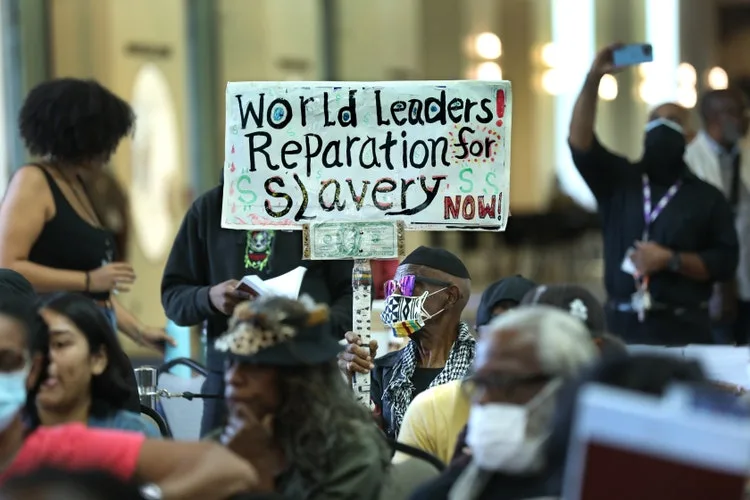Image

Image Credit
Carolyn Cole / Contributor via Getty Images
Image Alt
Walter Foster, age 80, holds up a sign that reads “World Leaders! Reparations for slavery now!”
Image Size
landscape-medium
Image Position
center
One of the main challenges of reparations is determining how much money to consider an appropriate repayment. How much does centuries of disenfranchisement cost? What is the appropriate amount to make up for the 400 years of free enslaved labor that built this country? The truth is, there is no amount of money, land, education or resources that could ever account for the atrocities performed against Black people or the pain and suffering they experienced during slavery, reconstruction, Jim Crow and beyond.
However, African American descendants of enslaved peoples deserve more than the failed promise of 40 acres and a mule that was proposed in 1865. While the U.S. government cannot turn back time, here are seven reparations ideas to ensure that African Americans are properly and rightfully recompensed.
1. Student loan forgiveness
According to the White House Initiative on Educational Excellence for African Americans, Black students are 40 percent more likely to take out student loans and graduate with almost $25,000 more in debt than their white counterparts. This discrepancy is one of the major contributors to the racial wealth gap between Black and white Americans.
During the COVID-19 pandemic, student loan payments were placed on hold through the CARES Act under the Donald Trump and Joe Biden administrations. In the summer of 2023, just before the student loan repayment pause ended, the Supreme Court rejected President Biden’s student loan relief plan, which would have forgiven up to $20,000 of debt per borrower.
Per the Roosevelt Institute, canceling $50,000 of student debt per borrower would result in a 40 percent increase in wealth for African Americans. As the conversation surrounding reparations continues, forgiving student debt for the descendants of enslaved peoples would make a significant impact on closing the income inequality gap. It would also give African Americans a better opportunity to participate in the economy and generate wealth through homeownership, retirement planning, investment portfolios and more.
2. Housing assistance and homeownership
Providing African Americans with grants for down payments, lower interest rates on mortgages and rental assistance would be a great step in righting the wrongs of the past. During the Great Depression, President Franklin D. Roosevelt enacted a collection of programs known as the New Deal to help stimulate the economy. One of those programs included the National Housing Act and Home Owners’ Loan Act, which would prevent foreclosures and provide home-buying assistance through the Federal Housing Administration.
Many Black buyers were not offered aid because providing mortgages in predominantly African American neighborhoods was restricted. Areas on the map were colored in red because those areas were considered high-risk. This practice, known as redlining, led to segregated housing and a significant increase in homeownership for white Americans, which further widened the wealth gap.
Some may believe that discrimination from the New Deal programs is a thing of the past, but Black communities are still facing its aftermath. According to the Center for American Progress, 74 percent of redlined neighborhoods are considered low-to-moderate income, and 60 percent of those areas are communities of color — which is a display of how institutional racism greatly interferes with generational wealth.
How do we fix it? State governments can start by examining the parts of the country with a housing reparation plan in places like Evanston, Illinois. In 2020, the city established a plan to repay their Black residents by using taxes from the sale of cannabis products to provide housing assistance. The plan includes $25,000 toward a home for residents, or their descendants, who have lived in Evanston between 1919 and 1969. Several state and city governments are implementing methods to provide housing support as a means of reparations.
3. Free college tuition
Ridding students of the burden of debt would not only be a reparative act, but it would also make higher education more accessible to American descendants of enslaved peoples. The average rate of college tuition and housing is about $20,000 a year for public colleges and even more for private universities. The Center for American Progress reports that 69 percent of Black students drop out of college due to student debt.
Before the national student loan deferment in 2020, the typical student loan payment for those who were actively making payments was between $200 and $299 per month, according to the Federal Reserve. Removing the weight of those payments would not only incentivize students to enroll in universities and graduate, but it may also encourage them to pursue graduate degrees.
Several universities already provide free tuition for Indigenous students, including the University of California system, the University of Arizona, the University of Montana, and the University of Maine where Indigenous student retention increased over the national average of 41 percent because of their tuition programs, per NPR. The tuition models used at these universities should also be applied to African American students. Higher education can be an effective avenue for success, and Black students deserve the opportunity to receive this education without the burden of paying high tuition rates.
4. Returning land
The theft of Black-owned land has gone unnoticed for too long. According to Inequality.org, 90 percent of the 14 million acres of Black-owned land in the 20th century was confiscated in the 21st century.
California Gov. Gavin Newsom is at the forefront of reparation efforts like returning historically stolen land to its rightful owners. In 2021, Newsom signed a senate bill that returned Bruce’s Beach to the descendants of Willa and Charles Bruce, who owned the land before it was seized through eminent domain by Manhattan Beach city officials in 1924.
After learning about the area, Manhattan Beach resident and activist Kavon Ward rallied the community and led the fight for the rightful return of the property. Ward is continuing her efforts through Where Is My Land, an organization she co-founded to help Black families reclaim the land that was once theirs.
The state of California developed a reparations task force that conducted a report with restitution plans for African Americans, including amendment efforts for seized homes. If California can do it, other states can follow suit.
5. Maternal health resources
Due to racial discrimination in medicine, Black women are at least three times more likely to die from pregnancy-related causes than white women. This critical issue was highlighted in popular culture when tennis champion Serena Williams almost died from a pulmonary embolism during childbirth — her claims of having shortness of breath were disregarded. At eight months of pregnancy, Olympic sprinter Tori Bowie died after suffering from complications during premature labor.
In addition to this, historically, the bodies of enslaved women were used for gynecological experiments by physician J. Marion Sims, among others. This history, and the false belief that Black skin is stronger and thicker than its counterparts’, have impacted how Black women are treated in healthcare.
A study by the Proceedings of the National Academy of Sciences uncovered that preconceived racial misconceptions about physical differences between African Americans and white Americans affect the ways in which white medical staff perceive pain in their Black patients. For this reason, Black mothers should be provided subsidized maternal care. Childbirth on its own can be a traumatic experience, and medical discrimination can drastically exacerbate that trauma.
This reparation effort can include the provision of prenatal and postpartum care by either a doula or a midwife to ensure that soon-to-be parents have someone to advocate for them. An NIH study reported that participants with doula care were less likely to use epidurals in labor and more likely to begin breastfeeding. Black women deserve to feel safe and comfortable during and after childbirth, so prioritizing their care is crucial.
As more states legalize cannabis use and the industry is becoming more and more lucrative, nonviolent cannabis-related convictions should be expunged. According to Business Insider, 70 percent of top executives from the 14 largest cannabis companies are white men. The ACLU reports that Black people are almost four times as likely to be arrested for marijuana possession.
Misdemeanor and felony records mean that offenders lose their basic rights like voting, travel, parental rights and social welfare programs, which decreases the opportunities for jobs and self-sustainability, and subsequently increases the likelihood of recidivism. Effective restorative justice would allow the formerly incarcerated for nonviolent cannabis offenses to participate in the business side of the industry.
In 2022, New York Mayor Eric Adams established a cannabis equity program, which provides cannabis licenses to those previously arrested or affected by New York’s former drug laws. One of the most significant ways for reparations to work and equity to manifest is by ensuring that those who were arrested and served time for cannabis-related offenses are compensated, able to participate in the industry and gain financial freedom.
7. Direct payouts
As a capitalistic society, money talks in the United States. Providing reparations through either a direct one-time payment or monthly installments could create a substantial impact on reducing the wealth disparity between Black and white Americans.
The U.S. government is no stranger to direct reparative payments. Under the Ronald Reagan administration, the Civil Liberties Act of 1988 was enacted to atone for the racist and unjust imprisonment of Japanese Americans during World War II. Eligible Japanese Americans were paid $20,000 in restitution. While the amount was not nearly enough, this proves that the U.S. government can provide reparations for African Americans.
Similarly to what California and Massachusetts have already done, each state can develop a reparations task force with the help of economists to determine a justifiable cash payment for the descendants of enslaved peoples.


